Showing Spotlights 137 - 144 of 547 in category All (newest first):
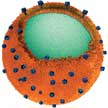 Cell membrane coating is a platform technology that presents a facile top-down method for designing nanocarriers with surfaces that directly replicate the highly complex functionalities necessary for effective biointerfacing. This new class of biomimetic nanoparticles combines the advantages of both natural and artificial nanomaterials. Cell membrane-coated nanoparticles are characterized by a synthetic nanoparticulate core cloaked by a layer of natural cell membrane.
Cell membrane coating is a platform technology that presents a facile top-down method for designing nanocarriers with surfaces that directly replicate the highly complex functionalities necessary for effective biointerfacing. This new class of biomimetic nanoparticles combines the advantages of both natural and artificial nanomaterials. Cell membrane-coated nanoparticles are characterized by a synthetic nanoparticulate core cloaked by a layer of natural cell membrane.
Jun 21st, 2018
 Drug abuse and dependence/addiction are complex disorders that are regulated by a wide range of interacting networks of genes and pathways that control a variety of phenotypes. Therefore, both identification of the at-risk population and treatment of the addiction disorders are strongly reliant on the development of new and innovative approaches for understanding the mechanisms underlying drug dependency and addiction. There are potential capacities of nanotechnology for the field of drug dependency and addiction.
Drug abuse and dependence/addiction are complex disorders that are regulated by a wide range of interacting networks of genes and pathways that control a variety of phenotypes. Therefore, both identification of the at-risk population and treatment of the addiction disorders are strongly reliant on the development of new and innovative approaches for understanding the mechanisms underlying drug dependency and addiction. There are potential capacities of nanotechnology for the field of drug dependency and addiction.
Jun 1st, 2018
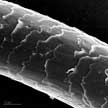 Scientists have discovered that the hierarchical micro- and nanostructures of human hair can be turned into hierarchical micro- and nanoparticles with a simple top-down procedure and be used as a novel type of biomaterial for medical applications. This strategy of preparing biomaterials from abundant human hair might provide a potent tool for producing autogenous materials from patients themselves to overcome the drawbacks of synthetic materials.
Scientists have discovered that the hierarchical micro- and nanostructures of human hair can be turned into hierarchical micro- and nanoparticles with a simple top-down procedure and be used as a novel type of biomaterial for medical applications. This strategy of preparing biomaterials from abundant human hair might provide a potent tool for producing autogenous materials from patients themselves to overcome the drawbacks of synthetic materials.
May 30th, 2018
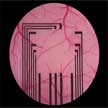 Although advances in optical technologies such as multi-photon microscopy and optogenetics have revolutionized researchers' ability to record and manipulate neuronal activity, integration of optical modalities with electrical recordings is challenging due to generation of light-induced artifacts. In new work, scientists report a transparent graphene microelectrode neural implant that eliminates light-induced artifacts to enable crosstalk-free integration of 2-photon microscopy, optogenetic stimulation, and cortical recordings in the same in vivo experiment.
Although advances in optical technologies such as multi-photon microscopy and optogenetics have revolutionized researchers' ability to record and manipulate neuronal activity, integration of optical modalities with electrical recordings is challenging due to generation of light-induced artifacts. In new work, scientists report a transparent graphene microelectrode neural implant that eliminates light-induced artifacts to enable crosstalk-free integration of 2-photon microscopy, optogenetic stimulation, and cortical recordings in the same in vivo experiment.
May 24th, 2018
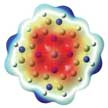 Sonodynamic therapy (SDT) has attracted wide attention as a novel treatment strategy for deep-seated tumors due to its safety, tissue penetration depth and low cost. However, traditional organic sonosensitizers tend to suffer from low water solubility, fast metabolism and elimination from the blood circulation. Sciebtists now report the excellent potential of metal-organic-framework (MOF)-derived mesoporous carbon nanostructures containing porphyrin-like metal centers in SDT augmentation.
Sonodynamic therapy (SDT) has attracted wide attention as a novel treatment strategy for deep-seated tumors due to its safety, tissue penetration depth and low cost. However, traditional organic sonosensitizers tend to suffer from low water solubility, fast metabolism and elimination from the blood circulation. Sciebtists now report the excellent potential of metal-organic-framework (MOF)-derived mesoporous carbon nanostructures containing porphyrin-like metal centers in SDT augmentation.
May 3rd, 2018
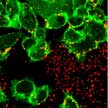 Scientists report an innovative nanotechnological approach for inhibiting the proliferation of breast cancer cells. For the first time, a wireless treatment based on piezoelectric nanoparticles has been exploited to remotely deliver electric stimulations to breast cancer cells. The team shows that chronic electric stimulations mediated by piezoelectric nanoparticles result in the ability to significantly reduce the breast cancer cell proliferation by affecting the ion homeostasis and the organization of the mitotic spindles during cell division.
Scientists report an innovative nanotechnological approach for inhibiting the proliferation of breast cancer cells. For the first time, a wireless treatment based on piezoelectric nanoparticles has been exploited to remotely deliver electric stimulations to breast cancer cells. The team shows that chronic electric stimulations mediated by piezoelectric nanoparticles result in the ability to significantly reduce the breast cancer cell proliferation by affecting the ion homeostasis and the organization of the mitotic spindles during cell division.
May 2nd, 2018
 The growing threat of antibiotic-resistant bacterial strains may pose grave risks for society: A post-antibiotic era means, in effect, an end to modern medicine as we know it. New research findings could point the way to new treatments for now-invincible bacterial foes, not by developing a new antibiotic that would kill these bacteria, but by making them weaker so that they get more easily attacked by our immune system. Understanding the physical mechanisms that underlie this persistent stickiness at the molecular level is instrumental to combat these invaders.
The growing threat of antibiotic-resistant bacterial strains may pose grave risks for society: A post-antibiotic era means, in effect, an end to modern medicine as we know it. New research findings could point the way to new treatments for now-invincible bacterial foes, not by developing a new antibiotic that would kill these bacteria, but by making them weaker so that they get more easily attacked by our immune system. Understanding the physical mechanisms that underlie this persistent stickiness at the molecular level is instrumental to combat these invaders.
Apr 20th, 2018
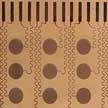 Sensory substitution with flexible electronics is one of the intriguing fields of research that takes place in nanotechnology labs around the world. In line with this focus on human senses, in the future artificial retinas integrated with the human body may not only repair damaged vision but also expand it to see a wider range wavelengths (e.g. ultraviolet light). Researchers now have demonstrated a new self-powered brain-linked vision electronic skin (e-skin) for mimicking the human retina. The general idea of our device design of brain-linked vision electronic skin is constructing an integrated flexible system including photodetector array, information analyzer, signal transmitter, and electricity power unit.
Sensory substitution with flexible electronics is one of the intriguing fields of research that takes place in nanotechnology labs around the world. In line with this focus on human senses, in the future artificial retinas integrated with the human body may not only repair damaged vision but also expand it to see a wider range wavelengths (e.g. ultraviolet light). Researchers now have demonstrated a new self-powered brain-linked vision electronic skin (e-skin) for mimicking the human retina. The general idea of our device design of brain-linked vision electronic skin is constructing an integrated flexible system including photodetector array, information analyzer, signal transmitter, and electricity power unit.
Apr 18th, 2018
 Cell membrane coating is a platform technology that presents a facile top-down method for designing nanocarriers with surfaces that directly replicate the highly complex functionalities necessary for effective biointerfacing. This new class of biomimetic nanoparticles combines the advantages of both natural and artificial nanomaterials. Cell membrane-coated nanoparticles are characterized by a synthetic nanoparticulate core cloaked by a layer of natural cell membrane.
Cell membrane coating is a platform technology that presents a facile top-down method for designing nanocarriers with surfaces that directly replicate the highly complex functionalities necessary for effective biointerfacing. This new class of biomimetic nanoparticles combines the advantages of both natural and artificial nanomaterials. Cell membrane-coated nanoparticles are characterized by a synthetic nanoparticulate core cloaked by a layer of natural cell membrane.
 Subscribe to our Nanotechnology Spotlight feed
Subscribe to our Nanotechnology Spotlight feed





